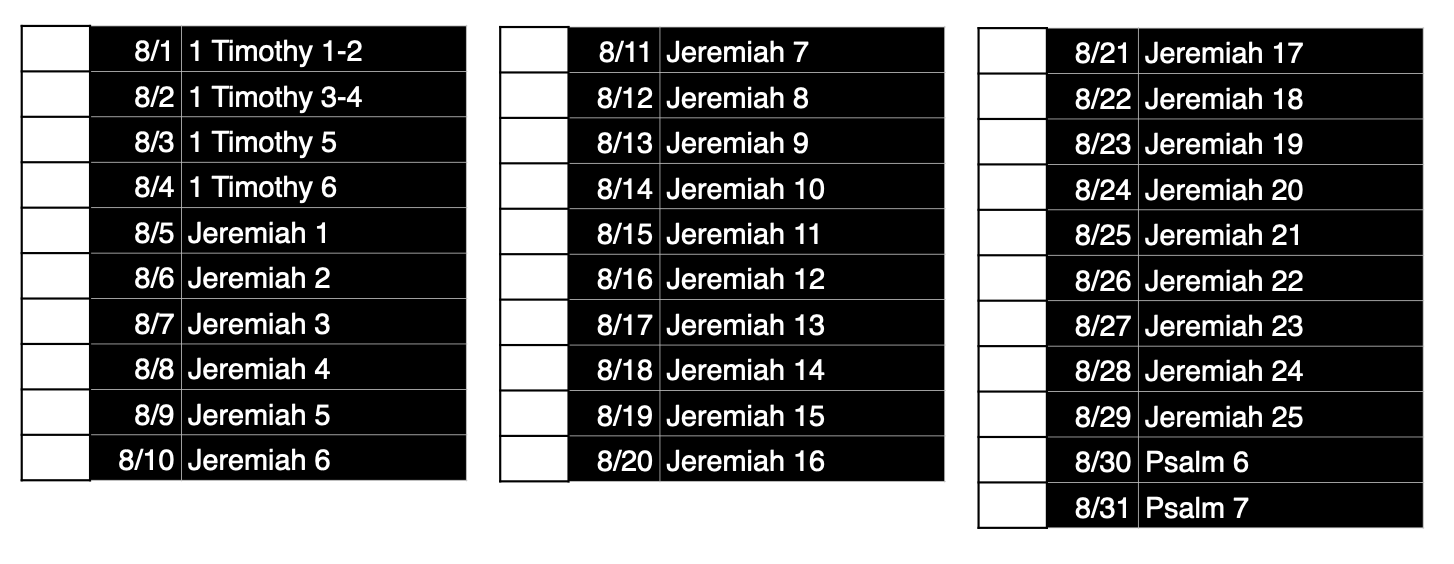August Bible Reading Plan
DAILY READINGS
Books: 1 Peter, Matthew, Hosea

TIMOTHY
Timeline (Approximate)

Authorship and Purpose:
The book of 1 Timothy was written by the apostle Paul sometime between 62-64 AD to Timothy, who worked alongside Paul and was sent to deal with problems troubling the church at Ephesus. False teachers were stirring up arguments and misleading others with their teachings, specifically on the Torah (the law/first five books of the Old Testament) and the genealogies within it. As a result, there were disruptions in the church gatherings and people were being led astray from true faith in Christ. Correct doctrine is incredibly important, not just because we need to know the truth, but because correct doctrine leads to right living. By combating these false teachers, Paul, through Timothy, is not only correcting doctrine, but correcting the disruptions facing the church at Ephesus.
Reading Timothy:
1 Timothy is a letter, referred to as an epistle, and is written to address specific problems in a specific context. Even so, 1 Timothy, as Scripture, contains truths which are important for Christians throughout history. Keeping both factors in mind are important for understanding the book and working through some of the challenges the text poses to contemporary readers.
Notably, the discussion on who can assume the role of pastor and teach in the church poses interpretational challenges. Godly scholars and church leaders differ on what these passages mean, but wherever one lands, it is important to keep in mind both Paul’s context and the Bible as a whole. Paul is not saying that all women should always remain quiet in the church (see 1 Cor. 11:5 where he assumes women are praying and prophesying in church), nor is he saying they should never participate in ministry (ex. Phoebe, Junia, Pricilla). The whole of the Bible elevates not only women, but places all of us, regardless of social status or divisions, on a level playing field in the kingdom of God (see both Matt. and Luke’s account of the Sermon on the Mount, 1 Cor. 12:13, Gal. 3:29-29). So, wherever one lands on the spectrum, all people are to be viewed as equals in the kingdom regardless of role. We are all one, united people of God.
Key Themes:
Right doctrine leads to right living — A proper understanding of the Gospel leads to a proper way of living for disciples of Jesus. If we do not properly understand the Gospel, we won’t live in accordance to the way of life Jesus calls us to as His disciples.
Structure:
- Greeting — (1:1-3)
- The false teachers & Timothy’s commission — (1:4-20)
- Instruction for the church — (2:1-6:2)
- Timothy’s commission pt2 — (6:3-20)
JEREMIAH
Timeline (Approximate)
Authorship and Purpose:
The book of Jeremiah contains a collection of words from the prophet Jeremiah, who prophesied in Jerusalem in the last decades before the exile to Babylon. Jeremiah’s words were written down, at least partially, by the scribe Baruch (36:1-8, 27-32), who was tasked with compiling all of Jeremiah’s teaching about 20 years after he began his ministry.
By the time Jeremiah began prophesying, Israel had become an unjust and unfaithful people. They were worshiping idols outside the temple, neglecting the societal outcast, and were generally failing to remain faithful to the covenant established in Exodus (see Jer. 7). God, speaking through Jeremiah, pronounces judgment upon Israel for their unfaithfulness, yet this judgment is not without hope. A time will come when God will call forth a remnant of Israel and establish a new covenant with them (Jer. 31:31). This people will be God’s people, and God will be with them as their God, cleansing them of their sin and writing the Torah (law) on their hearts.
Reading Jeremiah:
As prophetic literature, Jeremiah is commenting on Judah’s situation from God’s perspective. Prophecy includes but is not limited to speaking about future events which will take place. The prophets functioned as God’s mouthpiece, and in the case of Jeremiah, that meant speaking judgment over the unfaithfulness of Judah. Despite words of hope, Jeremiah was not liked by many in Jerusalem, including some of the kings, one of whom threw the first collection of Jeremiah’s words into a fire (36:23).
The book of Jeremiah consists of not only narrative sections, but also large sections of poetry. One important features to look for in reading Hebrew poetry is parallelism, or the “rhyming” of ideas. Often time a singular ideas will be repeated or developed in the course of a stanza to highlight an important point. This repetition or development of an idea allows the text to communicate on a deeper, emotional level rather than simply stating, for example, that Israel was unfaithful. Ultimately, though analyzing poetry is important, poetry as a literary form works best when it moves the reader. Allowing the poems of grief, judgment, and hope move you as you read the text will better communicate Jeremiah’s message.
Key Themes:
God’s Judgment — Though God is gracious and merciful, He is still just and will pass judgment on sin. Israel had been consistently unfaithful to the covenant and were neglecting the vulnerable in society, and so after patiently waiting for them to repent, God is going to pass judgement upon them with exile to Babylon.
The New Covenant — After the exile, God will call forth a faithful remnant and will establish a new covenant with this people. This new covenant will be an everlasting covenant, and was established in Jesus by His blood.
Structure of Jeremiah:
- Jeremiah’s call — (1)
- Accusation and warning — (2-25)
- Judgment and hope for Israel — (26-45)
- Judgment and hope for all nations — (46-51)
- Destruction of Jerusalem and exile — (52)
